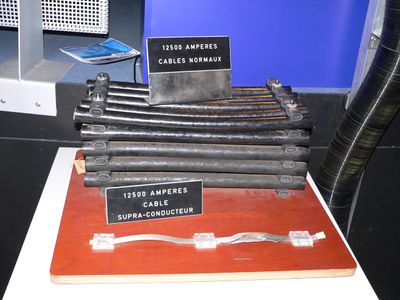Ampacity: Difference between revisions
No edit summary |
m (1 revision imported) |
||
| (2 intermediate revisions by 2 users not shown) | |||
| Line 1: | Line 1: | ||
[[Category:Done | [[Category:Done 2020-02-29]] | ||
[[category:electricity]] | [[category:electricity]] | ||
[[File:CERN-cables-p1030764.jpg|400px|right|thumb|Figure 1. Both | [[File:CERN-cables-p1030764.jpg|400px|right|thumb|Figure 1. Both cables are rated for 12,500 amps. The bottom cable is a [[superconductor]].<ref>By Rama - Own work, CC BY-SA 2.0 fr, https://commons.wikimedia.org/w/index.php?curid=601147 accessed May 9th, 2018.</ref>]] | ||
<onlyinclude>Ampacity (measured in [[ampere]]s (A)) is the maximum | <onlyinclude>Ampacity (measured in [[ampere]]s (A)) is the maximum [[current]] that can be safely carried by a given [[wire gauge]] (in the [[wire gauge|American wire gauge system]]). </onlyinclude>Lower [[wire gauge]]s in the American Wire Gauge system, have higher ampacity, meaning that the wire can carry more current. As current passes through a wire, it gets a little [[temperature|hotter]]; the more current passing through the wire the hotter it gets. If the ampacity rating is surpassed the [[insulation|insulating]] material is susceptible to damages, and a fire can result<ref>"Conductor ampacity" internet: http://www.allaboutcircuits.com/vol_1/chpt_12/3.html</ref>. | ||
As shown in figure 1, [[superconductor]]s have a tremendously large ampacity compared to [[metal]] wire. Superconductors need to be very cold in order to function. If they go above their critical [[temperature]], their [[resistance]] increases quite a bit! | As shown in figure 1, [[superconductor]]s have a tremendously large ampacity compared to [[metal]] wire. Superconductors need to be very cold in order to function. If they go above their critical [[temperature]], their [[resistance]] increases quite a bit! | ||
Latest revision as of 15:32, 28 April 2020
Ampacity (measured in amperes (A)) is the maximum current that can be safely carried by a given wire gauge (in the American wire gauge system). Lower wire gauges in the American Wire Gauge system, have higher ampacity, meaning that the wire can carry more current. As current passes through a wire, it gets a little hotter; the more current passing through the wire the hotter it gets. If the ampacity rating is surpassed the insulating material is susceptible to damages, and a fire can result[2].
As shown in figure 1, superconductors have a tremendously large ampacity compared to metal wire. Superconductors need to be very cold in order to function. If they go above their critical temperature, their resistance increases quite a bit!
For Further Reading
For further information please see the related pages below:
References
- ↑ By Rama - Own work, CC BY-SA 2.0 fr, https://commons.wikimedia.org/w/index.php?curid=601147 accessed May 9th, 2018.
- ↑ "Conductor ampacity" internet: http://www.allaboutcircuits.com/vol_1/chpt_12/3.html


